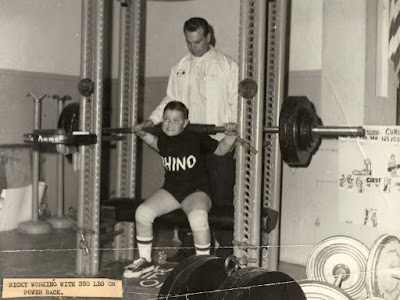If you don't have this book yet, get it. No kidding, not shitting, really. In my view this 200 page gem holds some of Mark Rippetoe's finest writing. The anecdotes, advice and opinions herein will serve you well down the long road, and I've found that each time I return, even to just scan at random, I come away with something I've either conveniently 'forgotten', or never bloody knew in the first place. Classic Rippetoe, this, and not to be missed. Come to think of it, if Strength & Health was still happening, not that tail end of run model, I mean the era with Starr, Suggs, McCallum, etc, these article/essays would definitely have served the magazine well. By God, The Ghost of Boho would be happy to print the lot of it in monthly installments.
Can I have my five bucks now, Mark.
Times is tough!
Anyhow . . .
From the book:
"Bill (Starr) worked with me for several years while he was here. He was in town more often then. I value the things he taught me. One of those things was to try to be more receptive to instruction. One day while we were benching at David Anderson's gym he tried to explain some fine point of technique that had eluded me, and for some reason I wasn't trying very hard to learn.
"He stepped back and said, 'You know, it would be better if you would get more coachable.' I thought about that a lot, and I have tried to get and stay more coachable. This requires that I be mindful of the fact that I have many things to learn, even -- maybe especially -- about things I think I already know."
- There's a very important lesson waiting to be learned there, one we all could gain from.
Do get this book.
Okay, all seriousness and all kidding aside, this next article is one of many of the earlier batch that Ken Leistner wrote for Powerlifting USA, and I'm real happy to have the opportunity to share them. Thanks again, Jake! As always, the overwhelming majority of what was said then by men in the know rings true now. Just ask the Ghost of Boho next time you see him. One day in particular, in that elastic and expanding time that takes place now and then during the late reps of a hard high-rep squat set, from two dozen or so on up to the kicker, why, I struggled to keep my head on straight, gasped to grab a breath of fresh as it seemed to be disappearing from the room. Where in hell was the oxygen I had to have! Who's the wise guy hoggin' the inhalable!!! Lo and bloody behold, there he was . . . semitransparent, translucent and radiating the life force of 10,001 polka tournaments . . . The Ghost of Boho! Damned if that outrageous chest cavity of his wasn't suckin' up what I wanted and wanted right now. Anyhow, things do get a wee trifle weird when you exert yourself, don't they all just.

To the article . . .
I'm hopeful that the readers won't see the following attempt to turn PLUSA into Strength & Health. That's a funny thought. "Constipation and the Lockout: How I Won the YMCA Nationals" or some such rot. Well, it would be a fine piece for S & H but not for this publication. Weight training for the motor scooter enthusiast is also not quite what's waited for monthly. However, I would like to relate a few things that might be useful for the lifter.
This weekend, the U.S. is having its first attempt at deciding which club is the National champion in rugby union. As the final game has yet to be played I don't, at this point in time, know who is to be crowned. But for those who know rugby, understand full well that the REAL championship was settled in the first round, yesterday, when Old Blue of Berkeley (Calif.) defeated Old Blue of NYC in double overtime. No slap at the players representing Akron and St. Louis, but even if the West Coast boys should go into a terminal coma prior to their game vs. St. Louis, the deal has already gone down and even the St. Louis team would be hard pressed to truly believe themselves as being worthy of the accolades accompanying the National championship.
THE POINT? Many of the ruggers utilize weights to assist their game and having been a very minor part of Old Blue (NYC) fortunes a number of years ago, I was around long enough to realize that most of them, for all their talent,
don't know what the hell they're doing.
My cousin played wing forward for Old Blue for a few years, and represents this year's Eastern Rugby Union championship club as their hooker. He began his lifting career while still under my tutelage as a high school student (he at least listened then), and his ability to work hard made him a very effective linebacker at 5'5" and 160 lbs. He continued his lifting as an adjunct to rugby, again needing an edge due to his small stature. He utilized the following routine prior to the last few rugby seasons with the side benefit of adding quite a bit to his powerlift total.
As necessary background, he long trained under a systematic routine as discussed in some of my previous articles; squats, deadlift, presses, curls, benches; low reps, total out every few weeks etc. Still being done by most powerlifters to this day. He was one of the students caught up in the groundswell of 'training to failure', but the shortcomings of burning yourself out every workout became obvious. One thing we noted (as I at one time tried the same route), was that we could no longer use heavy weights.
As an example, he was using 300 for 30 reps in the squat (28 may have been his best at that point), yet had
much difficulty doing a triple with 350. You tend to get very tenacious blasting out tough, high rep sets, but the fear of heavy weights will be upon you.
[What an instructional and beautifully constructed line of writing that is!] I mention this as a number of fellows I've talked to recently are going towards higher reps (in and of itself not deleterious and god for a break, development, cardiovascular benefits), but it must be recalled, if not so strictly in the words of the immortal George Frenn ("anything over four reps a set is bodybuilding and won't do shit for your powerlifts" or words to that effect), that you will have a hell of a time lifting heavy weight if you never lifted heavy weights. Many reports by Eastern Europeans indicate, in relationship to the Olympic lifts, that any movements done with less than 80% of maximum tends to cause the development (and in time, the establishment) of motor neuron patterns different than those utilized when using weights above 80% (and certainly at the percentages close to 100 and even more than that for "contest" lifts used at meets).
Not wanting to totally abandon his high rep work, Tommy began squatting twice a week (and keep in mind that this was in addition to a daily ten hour shift as a structural ironworker, and daily running of approximately 6-13 miles), in the following manner:
12 rep warmup
8 reps
6 reps
4 reps
Single to 90% (100% every two weeks)
10 reps.
Actually, almost standard to what most guys do. I think the difference lies in the fact that his backoff set of 10 was
an all out effort, in essence, going to failure that last set. Many lifters feel that twice a week to even 90% of limit might be a bit much, but this brings up an interesting point.
First, let's keep in mind that he's not lifting 12 months a year. He'll lift throughout the Spring and Fall seasons but at an intensity that is greatly reduced, and perhaps this will be only once per week. Also, his constant running (and the nature of his work may contribute to this) makes it impossible to go 90% of limit. In reality his 90% is closer to 80%, but in the off season,when he'll give more concentration to lifting (not by adding sets, days, etc., but rather, just put his head to it), and cut his running down to twice a week, at least for a while, his maximum single and doubles go up significantly. Also, his past propensity for doing 30's with anywhere between 300 and 350 have built an incredible foundation for heavy singles.
The applications? Well, especially for beginners, those just coming back after a lengthy layoff or injury spree, those in an ever deepening rut, a few weeks or months (perhaps three months maximum) of doing higher reps (20 to 30) may be very beneficial.
We would do them like this, just so that the proper meaning has been given. 20 minutes of stretching, runs up stairs (these were done for about six series - the stairs at work led up to the loft where we kept the weights - and we had to traverse 21 steps on the "short" runs and not quite double that on the "long" warmups), and then use a 135 lb. barbell to thoroughly stretch the thighs and hips, doing slow squats, widening the foot stance with each rep. This was done for one or two sets or until it was felt that we could get down to cases.
We would then take our weight for that day and do 30 reps. "Hey, Jack, be serious, jump 135 to 330, you be crazy!" Well, yeah, let me put it like this; if you can do 30 reps with any weight, that weight is not a HEAVY weight for you. I'm not recommending walking into the gym, planting your self under 300 plus pounds and squatting. No way. Injuries, inability to perform at maximum ability due to lack of warmup, etc., we all know that trip. Note that we took close to a half hour just to warm up for this one set of squats. I don't recommend the usual trip of jumping 25 lbs. or whatever per set until you get to a heavy weight. Put all the effort into the one set for 30.
This is a lot different than going under a weight and trying to do a maximum of even 6 reps with it, following the same procedure. 300 to 400 pounds, while enough to do damage to the uninitiated, is not a whole lot of weight for a man who can do singles or doubles with almost twice that poundage. Psychologically, it may be tough to handle, but hey, that's what causes most lifters to waste probably 95% or their workout effort over the course of a few years.
Anyway, start the cycle with a very moderate weight, 185 prior to one rugby season (my last as I recall), and jump it 15 or 20 pounds each workout. We were both way over 300 for 30 in a few weeks. For the powerlifter, he will now be in a position (and this is especially true for the 220 pounders and above, not the exceptional ones who have no doubt maintained some form of cardiovascular ability, but the average 220 pounder and up) where he can train incredibly hard due to the increase in both muscular and cardiovascular endurance.
Psychologically, this can also be played to advantage. If you were to end this cycle at 400 for 30 reps, you just might have difficulty doing triples with 500 or even 450 (from our past experience). Again, this might not stem completely from having a crushing weight on the back, I'm not sure, and for those hollering about lack of connective tissue strength . . .
Science has yet to fully explain the causes underlying connective tissue changes as they relate to progressive resistance exercise. There are those who assume that connective tissue strength increases in an exact, but unknown proportion to muscle tissue strength. Fine, that's all acceptable. There are those who state that you need low reps for tendon and ligament strength. Also acceptable. Others cry out for support work in the rack. Also, just as acceptable. The only thing definitely known is that connective tissue increases do occur in relation to the strength increases made in lean muscle tissue. But the reasons as to why, how much, in what proportion, etc., well, keep in mind that they, the scientists, still don't know the why underlying the growth of muscle tissue. They know how to achieve it, but don't know why, and keep in mind also that knowing how to achieve it often is dependent on who's footing the research bills.
Okay, cycle down (in effect) to 400 for triples (or whatever your top weight for 30 was), and build triples and fives from there for a few months. I can only say that the psychological "break" (euphemistically used. I can't describe the horror that grips one faced with doing 30 reps in the full squat with a weight that he's never used for more than maybe five reps - Note, not that one was capable with that weight of performing a maximum of five reps, but rather, one never
did more than five reps with it on the way to heavier fives, threes, singles) of doing the high reps, the physical difference of doing high reps (if nothing else, some of the intervertebral discs will get some slack), and the sheer "differentness" (for lack of a more suitable word) will allow the average lifter to make large increases. We used this method with a number of our football players too, and although I don't care to go into the deadlift now, we had one kid who came back from a successful season of college ball, a kid who had never done singles (or in fact less than six reps in any one set), and he was capable of some strong triples with about 150 pounds or so more than he was using for 20s and 30s in the squat, including a deadlift of 675.
I just don't think you have to do singles to
do singles. But you have to work heavy. This is not to say that you have to work heavy all the time.
This article might prove useful at some point as well:
http://ditillo2.blogspot.ca/2008/02/squat-specialization-for-increased.html























